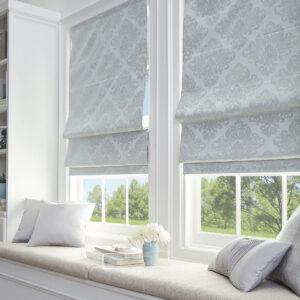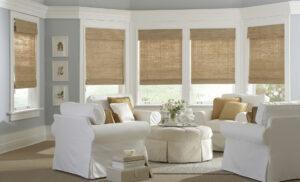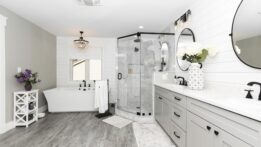 Replacing or updating window treatments can be a significant investment for your home. Each treatment is a feature expected to last for years to come. With many options for material and style, it can be difficult to decide on the best ones. To help, I have compiled information to help you narrow the choices and keep your home looking stylish and inviting.
Replacing or updating window treatments can be a significant investment for your home. Each treatment is a feature expected to last for years to come. With many options for material and style, it can be difficult to decide on the best ones. To help, I have compiled information to help you narrow the choices and keep your home looking stylish and inviting.
Before Deciding
When choosing window treatments, there are a few basic factors to keep in mind. Think about privacy, light regulation, and temperature control. For many, privacy is the most important consideration for window treatments. While common areas may remain more open to outside viewing, bathrooms and bedrooms require treatments that maximize privacy. The amount of privacy afforded by treatments normally depends on their material, ranging from sheer to multilayered blackout and solid materials. However, design also contributes to privacy. For example, vertical blinds tend to leave less open space than horizontal ones. The amount of light you want to let in will vary by room. Think about how much light you would like to have in each room. Typically, people prefer to have lots of natural light in areas like kitchens and living rooms because it creates a homey, inviting atmosphere. Whereas, in bedrooms, people may opt for less light and more privacy. Finally, window treatments affect temperature control. The thinner the material, the more light it lets in, the more heat you get. However, there are options that allow for UV protection while still letting some sun in, such as solar shades. Having energy efficient window treatments means that your A/C does not have to work as hard to keep rooms cool. If this is a top priority for you, then you can look for Attachments Energy Rating Council (AERC) products. These have been rated for both comfort and energy efficiency. Keeping these factors in mind as you consider each window treatment trend should help make the right choice for your home clear.
Roman Shades
 These simply designed yet versatile shades are a classic feature in the home, and it is easy to see why. Roman shades are typically made of cloth or fabric materials, so they are less expensive than wood or faux wood options. This also means they come in a large variety of colors and patterns. They are often used as statement pieces that draw the eye in a room with little color. Recently however, new styles feature minimalistic and understated designs that mesh well with the rest of the room rather than standing out. Whether bold or understated, Roman shades find popularity from their design. The shade compresses into neat folds when drawn up and unfolds smoothly when fully extended. If you have small children in the house and are concerned about hazardous cords, there are cordless designs that are adjusted simply by pushing them up and pulling them down with one hand.
These simply designed yet versatile shades are a classic feature in the home, and it is easy to see why. Roman shades are typically made of cloth or fabric materials, so they are less expensive than wood or faux wood options. This also means they come in a large variety of colors and patterns. They are often used as statement pieces that draw the eye in a room with little color. Recently however, new styles feature minimalistic and understated designs that mesh well with the rest of the room rather than standing out. Whether bold or understated, Roman shades find popularity from their design. The shade compresses into neat folds when drawn up and unfolds smoothly when fully extended. If you have small children in the house and are concerned about hazardous cords, there are cordless designs that are adjusted simply by pushing them up and pulling them down with one hand.
Natural Tones and Materials
 Whether shades, curtains, or blinds, people are choosing window treatments made from natural materials to bring some of the outside indoors. In an age where many work from their homes, interior décor has shifted to create a natural and light feeling for living spaces that is meant to increase productivity. Window treatments made from wood, bamboo, or natural fabrics contribute to this atmosphere. These natural tones and colors also fit in well with the popular minimalist style because they avoid bright colors and patterns. While materials like wood and bamboo may be more expensive than other options, they offer a high quality that will make them last longer than other materials. If wood is simply out of the budget, faux wood is a good alternative that brings the same aesthetic but costs less and actually does better in humid rooms than real wood. A good method for picking which natural tones to incorporate is looking at the tones already present in the room with furniture and wall color.
Whether shades, curtains, or blinds, people are choosing window treatments made from natural materials to bring some of the outside indoors. In an age where many work from their homes, interior décor has shifted to create a natural and light feeling for living spaces that is meant to increase productivity. Window treatments made from wood, bamboo, or natural fabrics contribute to this atmosphere. These natural tones and colors also fit in well with the popular minimalist style because they avoid bright colors and patterns. While materials like wood and bamboo may be more expensive than other options, they offer a high quality that will make them last longer than other materials. If wood is simply out of the budget, faux wood is a good alternative that brings the same aesthetic but costs less and actually does better in humid rooms than real wood. A good method for picking which natural tones to incorporate is looking at the tones already present in the room with furniture and wall color.
Layering
 If the natural, minimalist style is not for you and you want to have more versatility in your window treatments, try layering. This could be shades that fit the window and curtains on top, blinds and curtains, shades and blinds, curtain on curtain and so on. Many home improvers have a combination of soft and hard treatments. This option is attractive because it adds more texture to the window as well as more control over privacy and light regulation. If you love the idea of lots of natural light but do not want prying eyes at all hours, consider layering blackout material with light regulating material, such as blackout curtains with solar shades or sheer curtains behind them. There is no rule that says you have to choose just one treatment. This style is common in bedrooms and living rooms where residents typically spend the most time and want the most control.
If the natural, minimalist style is not for you and you want to have more versatility in your window treatments, try layering. This could be shades that fit the window and curtains on top, blinds and curtains, shades and blinds, curtain on curtain and so on. Many home improvers have a combination of soft and hard treatments. This option is attractive because it adds more texture to the window as well as more control over privacy and light regulation. If you love the idea of lots of natural light but do not want prying eyes at all hours, consider layering blackout material with light regulating material, such as blackout curtains with solar shades or sheer curtains behind them. There is no rule that says you have to choose just one treatment. This style is common in bedrooms and living rooms where residents typically spend the most time and want the most control.
Motorization
 Just as there are smart home systems for controlling sprinklers, the A/C, lights, and even the stove, there are motorized window treatments that allow you to control blinds, curtains, and shades. These new treatments may be more expensive than manual options but come with advantages worth considering. Motorized treatments are great options for those concerned with security. Many programs come with a feature that adjusts the treatments at various points throughout the day even if no one is present. This can give the impression that someone is home and discourage break-ins. This also makes a nightly routine for covering windows easy and convenient to do. The ability to easily adjust window treatments throughout the day can also increase energy efficiency. During the hottest parts of the day, the treatments can be closed to prevent the sun from heating up a room. Motorized treatments are also safe for homes with small children, as they eliminate the need for cords and can have motion sensors to stop movement if something obstructs their path.
Just as there are smart home systems for controlling sprinklers, the A/C, lights, and even the stove, there are motorized window treatments that allow you to control blinds, curtains, and shades. These new treatments may be more expensive than manual options but come with advantages worth considering. Motorized treatments are great options for those concerned with security. Many programs come with a feature that adjusts the treatments at various points throughout the day even if no one is present. This can give the impression that someone is home and discourage break-ins. This also makes a nightly routine for covering windows easy and convenient to do. The ability to easily adjust window treatments throughout the day can also increase energy efficiency. During the hottest parts of the day, the treatments can be closed to prevent the sun from heating up a room. Motorized treatments are also safe for homes with small children, as they eliminate the need for cords and can have motion sensors to stop movement if something obstructs their path.
You can accommodate both design and practicality so you can get the most out of your window treatments. Carefully consider factors, such as privacy, light regulation, and temperature control. With these in mind, you can choose the perfect set of blinds, curtains, or shades for you. ![]()
Jamie Soto
Home & Yard Magazine




